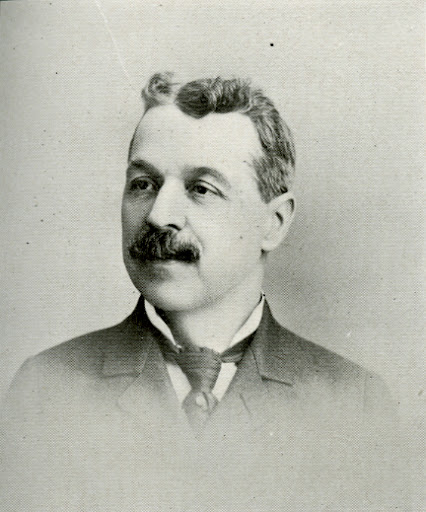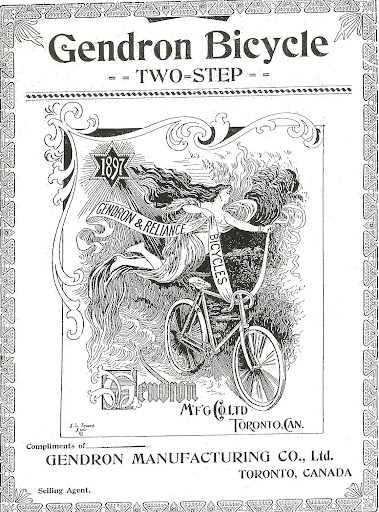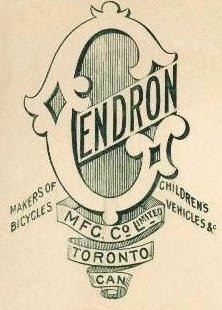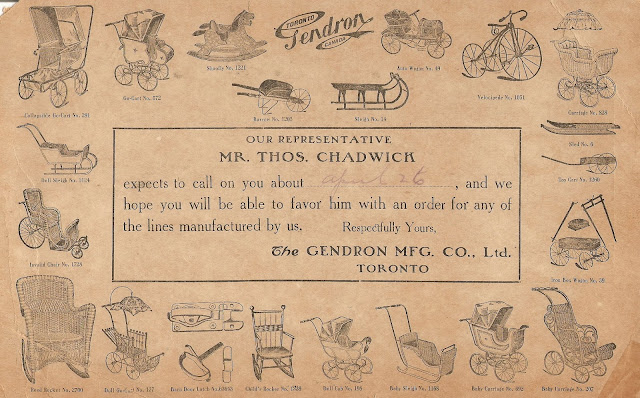Gendron Manufacturing Co.

It was in September 1899 that Walter Massey, in an attempt to strengthen his family’s position as Canada’s largest bicycle maker, amalgamated his bicycle works with that of the Welland Vale Manufacturing Co. of St. Catharines, the Goold Bicycle Co. of Brantford and the H.A. Lozier & Co. and the Gendron Mfg. Co., both of Toronto, to form what Massey and his partners called Canada Cycle & Motor Co. Ltd. (CCM).
 Based in Toledo, Ohio, the Gendron Mfg. Co. had been established by Peter Gendron (1844 - 1911) who, in 1865, at the age of 21, had left his father’s wagon works in St. Ours, Quebec, to move to Ohio where he found employment as a pattern maker for the Toledo Novelty Works. By 1871 Gendron had established his own business.
Based in Toledo, Ohio, the Gendron Mfg. Co. had been established by Peter Gendron (1844 - 1911) who, in 1865, at the age of 21, had left his father’s wagon works in St. Ours, Quebec, to move to Ohio where he found employment as a pattern maker for the Toledo Novelty Works. By 1871 Gendron had established his own business.
In 1874 the ingenious young French-Canadian was granted a patent for a lightweight, wire-spoke wheel he had designed. The wheel was quickly found to be more durable and much superior to the heavy, solid wooden wheels of the time. Gendron incorporated ball bearings into the hub to reduce the wear on the wheel as it turned on the axle and in 1880 established the Gendron Wheel Co. to install his invention on everything from baby buggies and doll carriages to wagons and wheelchairs. The first vehicles to use the new Gendron wheel were the large adult tricycles of the 1800’s.

In 1895 Gendron established the Gendron Mfg. Co. of Toronto and built an impressive brick factory at 411 Richmond St. in Toronto. Here his company began to produce not only bicycles and tricycles, but doll carriages and other children's toys as well.

Producing bicycles under the brand names of Gendron and Reliance, the Gendron Mfg. Co. claimed their bicycles were the fastest in the country. It was a feat, they said, made possible by the use of a three-point bearing in its wheels and a fact clearly demonstrated when the Rambler’s Bicycle Club of Toronto held a five-mile race at the Woodbine track on July 30, 1896.
At the meet the company noted that seventeen of the twenty competitors rode Gendron-made bicycles. Following the race the company promptly announced that the three competitors riding other makes had finished dead last.
Spurred by such success, the Gendron company challenged its competitors: “Now gentlemen of the old-fashioned bearing fame, you have long been preaching the excellence of your bearings, now is the time to give us proofs. Show us your credentials and give the public an account of your achievements. We are weary of your silly arguments. Substantiate your claims or keep quiet.” (1)

In July 1896 when the Goold Bicycle Co. of Brantford announced that its tandem bicycle had never been beaten in a race, the Gendron company pointed out that the only reason the Goold tandem had never been beaten was that it had never actually been in a race!

It was a dig that prompted the Brantford company to retort that the Gendron company knew more about “fancy frills and baby-carriage wheels” than it actually did about bicycles, a statement the Gendron folks dismissed as “the most contemptible style of advertisement ever printed in a Toronto paper.” (2)
The barbs continued to fly as the Gendron Mfg. Co. accused the Goold company of producing bicycles with “white-washed” rims, citing the tale of poor Harry Parkin, who, according to the Gendron company, was riding a Goold bicycle out the Kingston Road when the front forks gave out, causing the unfortunate cyclist to suffer “forty-eight hours of unconsciousness, six weeks in hospital, a scar on his face and a heavy bill for repairs.” (3)
The Gendron Mfg. Co. remained a major player in the Canadian bicycle market until the sale of its cycle works to CCM in 1899, following which the company turned its attention to the motor car. By 1920 Gendron had become the world’s largest maker of children’s pedal cars, manufactured to imitate the full-sized automobiles of the day. Sold under the name of Pioneer, the Gendron brand became synonymous with high quality pedal cars that featured cylindrical rear gas tanks, tool boxes, imitation cranks, and nickel trim.

The company stopped making children's vehicles in 1941, but continued to make wheelchairs and other hospital equipment.

1. Daily Mail & Empire, May 29, 1897
2. "We Beg to Tender Our Hearty Thanks to a Firm Handling Bicycles," The Globe, August 1, 1896
3. ibid.




